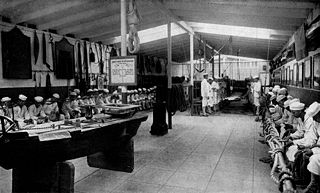 W
WRopework or marlinespike seamanship are traditional umbrella terms for a skillset spanning the use, maintenance, and repair of rope. Included are tying knots, splicing, making lashings, whippings, and proper use and storage of rope.
 W
WThe Admiraliteitslijnbaan is a 17th-century building on Oostenburgergracht canal in Amsterdam. It has held rijksmonument status since 1970. A plaque on one side of the building commemorates Czar Peter the Great, who may have stayed here in 1697 during his apprenticeship at the Amsterdam shipyards.
 W
WAkwete cloth is a unique hand woven textile produced in Igboland for which the town of Akwete in Abia state, Nigeria is famous. The traditional Igbo weaving as demonstrated in Akwete processes sisal, hemp, raffia, cotton or other fibres into finished products. While the coarse raffia materials are used by masquerades and in the past as head gear for warriors among other uses, the hemp material was used to weave towels, ropes and handbags. The more comfortable and colorful spun cotton is used to weave cloth for everyday wearing.
 W
WBaling twine or baler twine is a small diameter sisal or synthetic twine used to bind hay or straw into bales.
 W
WBelaying is a variety of techniques climbers use to create friction within a climbing system, particularly on a climbing rope, so that a falling climber does not fall very far. A climbing partner typically applies tension at the other end of the rope whenever the climber is not moving, and removes the tension from the rope whenever the climber needs more rope to continue climbing.
 W
WA bell pull is a woven textile, pull cord, handle, knob, or other object that connects with a bell or bell wire, and which rings a bell when pulled. Bell pulls may be used to summon workers in homes of people who employ butlers, housemaids, nannies or other domestic workers, and often have a tassel at the bottom. The bell pull is one element of a complex interior mechanical network which typically in Victorian times involved a range of bell pulls in different rooms; moreover, these bell connections link to a central bank of bells in a room where servants would await commands.
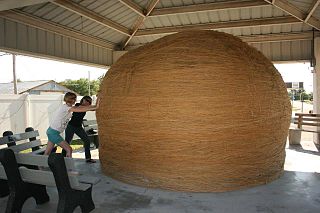 W
WThere are multiple claims to the world's biggest ball of twine record in the United States. As of 2014, the ball of twine with the largest circumference is located in Cawker City, Kansas.
 W
WA braid is a complex structure or pattern formed by interlacing two or more strands of flexible material such as textile yarns, wire, or hair. Historically, the materials used have depended on the indigenous plants and animals available in the local area. Braids have been made for thousands of years, in many different cultures around the world, for a variety of uses.
 W
WBrails, in a sailing ship, are small lines used to haul in or up the edges (leeches) or corners of sails, before furling. On a ship rig, these brails are most often found on the mizzen sail. The command is, hale up the brails, or, brail up the sails. The word brail comes from Middle English brayle, from Anglo-French braiel belt, strap, brail, alteration of Old French braiuel belt, probably ultimately from Latin braca pant.
 W
WCable lacing is a method for tying wiring harnesses and cable looms, traditionally used in telecommunication, naval, and aerospace applications. This old cable management technique, taught to generations of lineworkers, is still used in some modern applications since it does not create obstructions along the length of the cable, avoiding the handling problems of cables groomed by plastic or hook-and-loop cable ties.
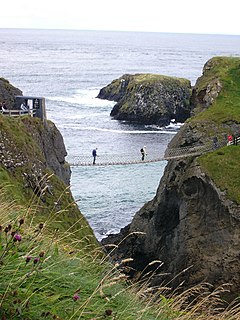 W
WThe Carrick-a-Rede Rope Bridge is a rope bridge near Ballintoy in County Antrim, Northern Ireland. The bridge links the mainland to the tiny island of Carrickarede. It spans 20 metres (66 ft) and is 30 metres (98 ft) above the rocks below. The bridge is mainly a tourist attraction and is owned and maintained by the National Trust. In 2018, the bridge had 485,736 visitors. The bridge is open all year round and people may cross it for a fee.
 W
WCat's cradle is one of the oldest games in recorded human history, and involves creating various string figures, either individually or by passing a loop of string back and forth between two or more players. The true origin of the name is debated, though the first known reference is in The light of nature pursued by Abraham Tucker in 1768. The type of string, the specific figures, their order, and the names of the figures vary. Independent versions of this game have been found in indigenous cultures throughout the world, including in Africa, Eastern Asia, the Pacific Islands, Australia, the Americas, and the Arctic.
 W
WA fid is a conical tool traditionally made of wood or bone. It is used to work with rope and canvas in marlinespike seamanship. A fid differs from a marlinspike in material and purposes. A marlinspike is used in working with wire rope, natural and synthetic lines, may be used to open shackles, and is made of metal. A fid is used to hold open knots and holes in canvas, and to separate the "lays" of synthetic or natural rope for splicing. A variation of the fid, the gripfid, is used for ply-split braiding. The gripfid has a jamming cleat to pull a cord back through the cord split by the fid's point.
 W
WHojōjutsu or Torinawajutsu or just Nawajutsu , is the traditional Japanese martial art of restraining a person using cord or rope, as a precursor to modern-day handcuffs. Encompassing many different materials, techniques and methods from many different schools, Hojōjutsu is a quintessentially Japanese art that is a unique product of Japanese history and culture.
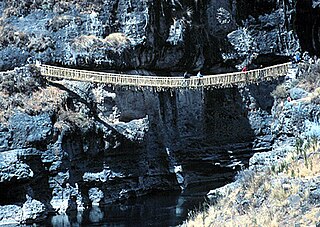 W
WInca rope bridges are simple suspension bridges over canyons, gorges and rivers (pongos) constructed by the Inca Empire. The bridges were an integral part of the Inca road system and exemplify Inca innovation in engineering. Bridges of this type were useful since the Inca people did not use wheeled transport – traffic was limited to pedestrians and livestock – and they were frequently used by Chasqui runners delivering messages throughout the Inca Empire.
 W
WKumihimo (組み紐) is a traditional Japanese artform of making braids and cords. Literally meaning "gathered threads", kumihimo are made by interlacing reels of yarn, commonly silk, with the use of traditional, specialised looms - either a marudai (丸台) or a takadai (高台).
 W
WA lanyard is a cord or strap worn around the neck, shoulder, or wrist to carry such items as keys or identification cards. In the military, lanyards were used to fire an artillery piece or arm the fuze mechanism on an air-dropped bomb by pulling out a cotter pin when it leaves the aircraft. They are also used to attach a pistol to a body so that it can be dropped without being lost. Aboard a ship, it may refer to a piece of rigging used to secure or lower objects.
 W
WA lashing is an arrangement of rope, wire, or webbing with linking device used to secure and fasten two or more items together in a somewhat rigid manner. Lashings are most commonly applied to timber poles, and are commonly associated with cargo, containerisation, the Scouting movement, and sailors.
 W
WManila rope is a type of rope made from manila hemp.
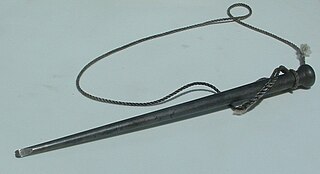 W
WMarlinspike is a tool used in marine ropework. Shaped in the form of a polished metal cone tapered to a rounded or flattened point, it is used in such tasks as unlaying rope for splicing, untying knots, drawing marline tight using a marlinspike hitch, and as a toggle joining ropes under tension in a belaying pin splice.
 W
WA marudai meaning "round stand" is the most common of the traditional frames used for making kumihimo, a type of Japanese braid.
 W
WNawashi (縄師), is a word which in SM circles means "rope artist". Nawashi are those who have some recognized proficiency in the historic erotic art of kinbaku (緊縛) or kinbaku-bi.
 W
WPioneering is the art of using ropes and wooden spars joined by lashings and knots to create a structure. Pioneering can be used for constructing small items such as camp gadgets up to larger structures such as bridges and towers. These may be recreational, decorative, or functional.
 W
WThe Plymouth Cordage Company was a rope making company located in Plymouth, Massachusetts, USA. The company, founded in 1824, had a large factory located on the Plymouth waterfront. By the late 19th century, the Plymouth Cordage Company had become the largest manufacturer of rope and twine in the world. The company specialized in ship rigging, and was chosen among other competitors in the early 1900s to manufacture the rope used on the USS Constitution. The company's twine, Plymouth binder twine, popular among farmers, was the inspiration for the naming of the Plymouth brand of automobiles first produced in 1928.
 W
WSingle-rope technique (SRT) is a set of methods used to descend and ascend on the same single rope. Single-rope technique is used in caving, potholing, rock climbing, canyoning, roped access for building maintenance and by arborists for tree climbing, although to avoid confusion in the tree climbing community, many have taken to calling it "stationary" rope technique.
 W
WTarring Is protecting some types of natural fibre and wire rope by coating it with tar. Hemp rope, which was typically used for standing rigging, requires tarring. Manila and cotton ropes were used for running rigging and were not tarred as this would make the rope too stiff to run easily through blocks. Regular tarring at sea was required when sailing ships used hemp rope - once every 6 months for a ship on a long voyage.
 W
WTouwfabriek Langman is one of the oldest rope making companies in Europe.
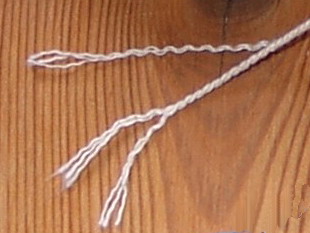 W
WTwine is a strong thread, light string or cord composed of two or more thinner strands twisted, and then twisted together (plied). The strands are plied in the opposite direction to that of their twist, which adds torsional strength to the cord and keeps it from unravelling. This process is sometimes called reverse wrap. The same technique used for making twine is also used to make thread, which is thinner, yarn, and rope, which is stronger and thicker, generally with three or more strands.
 W
WThe traditional wedding cord, also known as the wedding lasso, is a piece of wedding paraphernalia used in some Christian Catholic wedding ceremonies. This is actually a representation of a loop of rosary beads made out of white satin or silk. During the wedding proper, this is traditionally formed into a figure-of-eight shape, and then placed around the neck areas of the bride and the groom after they have made their wedding vows, and are already kneeling on pillows for the pronouncement of a wedding prayer. This cord symbolizes lifetime unity or the everlasting union of the bride and groom when they officially become husband and wife, as well as a symbol of marital protection; while the loops formed signifies their love for one another. After the wedding, this marital twine is typically kept by the bride as a wedding souvenir. Use of the traditional wedding cord for weddings is common in Hispanic countries such as Mexico, the Philippines, and Spain.
 W
WTo worm, parcel and serve a line is to apply a multi-layered protection against chafe and deterioration to standing rigging. It is a technique not usually used on modern small boats, but is found extensively on traditionally-rigged sailing ships. Worming, parcelling and serving —referred to collectively as "service"— is traditionally applied only to traditional twisted rope, either natural fiber or steel wire-rope, not the braided line almost exclusively used on modern vessels, but some traditional vessels now use modern high modulus braided lines in place of wire rope and serve the line to maintain the traditional appearance. It can be applied to the entire length of a line, such as a shroud, or selectively, to specific parts of a line, such as over the spliced ends of a stay, where the chafe on the middle section of the stay precludes complete protection.
 W
WA Z-Drag or Z-Rig is an arrangement of lines and pulleys commonly used in rescue situations. The basic arrangement provides a theoretical mechanical advantage of three. The name comes from the fact that the arrangement of lines is roughly Z shaped. Besides the mechanical advantage to pulling, it also uses only part of the total length of the rope for the block and tackle arrangement.